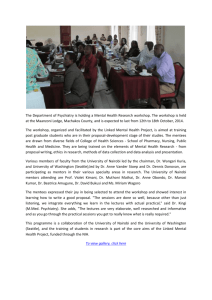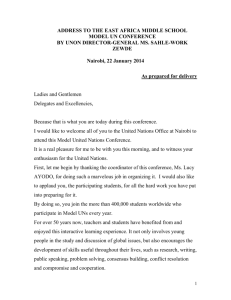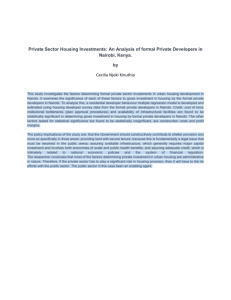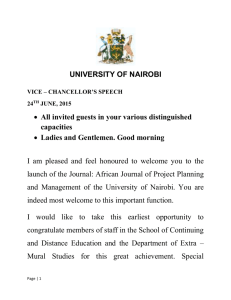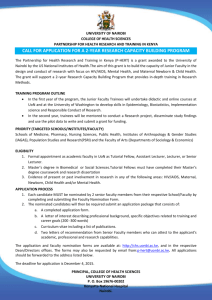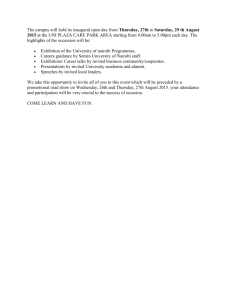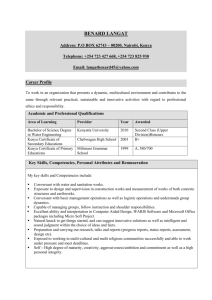RAINFALL-RUNOFF FLOOD MODELLING IN NAIROBI URBAN
advertisement
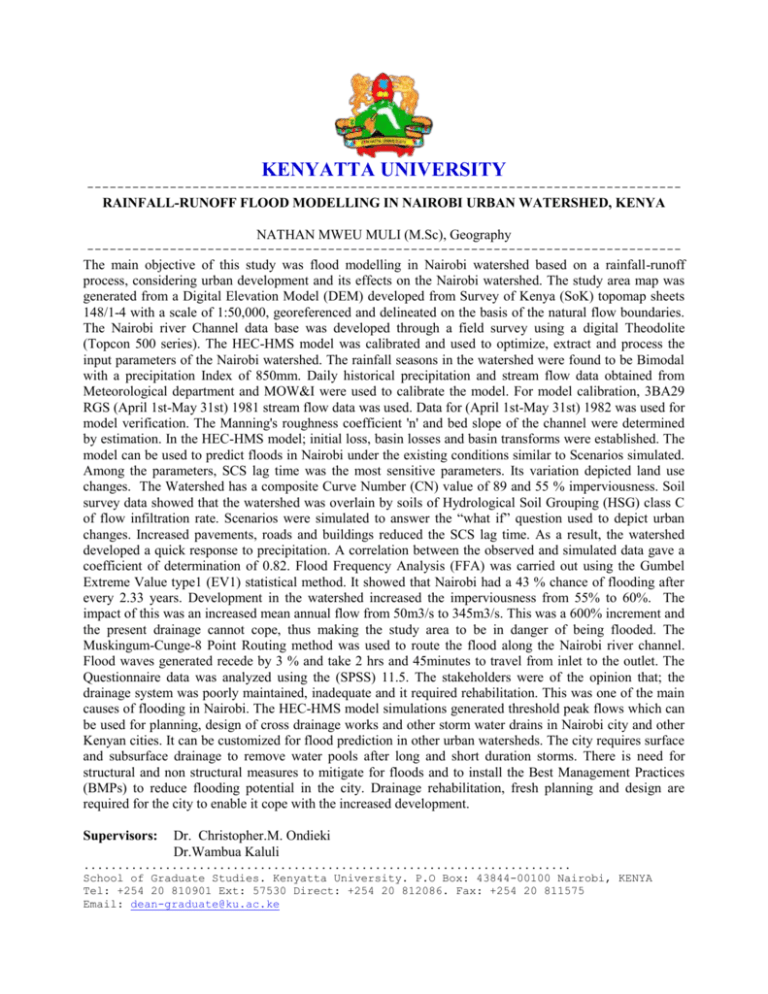
KENYATTA UNIVERSITY ------------------------------------------------------------------------------- RAINFALL-RUNOFF FLOOD MODELLING IN NAIROBI URBAN WATERSHED, KENYA NATHAN MWEU MULI (M.Sc), Geography ------------------------------------------------------------------------------- The main objective of this study was flood modelling in Nairobi watershed based on a rainfall-runoff process, considering urban development and its effects on the Nairobi watershed. The study area map was generated from a Digital Elevation Model (DEM) developed from Survey of Kenya (SoK) topomap sheets 148/1-4 with a scale of 1:50,000, georeferenced and delineated on the basis of the natural flow boundaries. The Nairobi river Channel data base was developed through a field survey using a digital Theodolite (Topcon 500 series). The HEC-HMS model was calibrated and used to optimize, extract and process the input parameters of the Nairobi watershed. The rainfall seasons in the watershed were found to be Bimodal with a precipitation Index of 850mm. Daily historical precipitation and stream flow data obtained from Meteorological department and MOW&I were used to calibrate the model. For model calibration, 3BA29 RGS (April 1st-May 31st) 1981 stream flow data was used. Data for (April 1st-May 31st) 1982 was used for model verification. The Manning's roughness coefficient 'n' and bed slope of the channel were determined by estimation. In the HEC-HMS model; initial loss, basin losses and basin transforms were established. The model can be used to predict floods in Nairobi under the existing conditions similar to Scenarios simulated. Among the parameters, SCS lag time was the most sensitive parameters. Its variation depicted land use changes. The Watershed has a composite Curve Number (CN) value of 89 and 55 % imperviousness. Soil survey data showed that the watershed was overlain by soils of Hydrological Soil Grouping (HSG) class C of flow infiltration rate. Scenarios were simulated to answer the “what if” question used to depict urban changes. Increased pavements, roads and buildings reduced the SCS lag time. As a result, the watershed developed a quick response to precipitation. A correlation between the observed and simulated data gave a coefficient of determination of 0.82. Flood Frequency Analysis (FFA) was carried out using the Gumbel Extreme Value type1 (EV1) statistical method. It showed that Nairobi had a 43 % chance of flooding after every 2.33 years. Development in the watershed increased the imperviousness from 55% to 60%. The impact of this was an increased mean annual flow from 50m3/s to 345m3/s. This was a 600% increment and the present drainage cannot cope, thus making the study area to be in danger of being flooded. The Muskingum-Cunge-8 Point Routing method was used to route the flood along the Nairobi river channel. Flood waves generated recede by 3 % and take 2 hrs and 45minutes to travel from inlet to the outlet. The Questionnaire data was analyzed using the (SPSS) 11.5. The stakeholders were of the opinion that; the drainage system was poorly maintained, inadequate and it required rehabilitation. This was one of the main causes of flooding in Nairobi. The HEC-HMS model simulations generated threshold peak flows which can be used for planning, design of cross drainage works and other storm water drains in Nairobi city and other Kenyan cities. It can be customized for flood prediction in other urban watersheds. The city requires surface and subsurface drainage to remove water pools after long and short duration storms. There is need for structural and non structural measures to mitigate for floods and to install the Best Management Practices (BMPs) to reduce flooding potential in the city. Drainage rehabilitation, fresh planning and design are required for the city to enable it cope with the increased development. Supervisors: Dr. Christopher.M. Ondieki Dr.Wambua Kaluli ........................................................................ School of Graduate Studies. Kenyatta University. P.O Box: 43844-00100 Nairobi, KENYA Tel: +254 20 810901 Ext: 57530 Direct: +254 20 812086. Fax: +254 20 811575 Email: dean-graduate@ku.ac.ke
